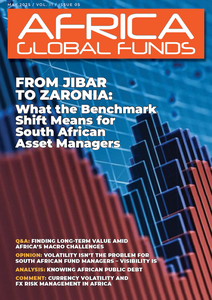Description
South Africa’s financial markets are in the midst of a profound transformation. A critical element of this shift is the phasing out of the Johannesburg Interbank Average Rate (JIBAR), long the cornerstone of interest rate benchmarks for floating-rate instruments in the country. In its place, the South African Reserve Bank (SARB) is introducing the South African Rand Overnight Index Average (ZARONIA)—a near risk-free rate (NRFR) designed to better reflect real market transactions while enhancing financial stability. What are the implications for SA asset managers? Read on pp. 12-13.
A more complex challenge for many African economies today is their growing external debt burden. Across the continent, nations have accumulated significant debt, driven by structural economic factors and external pressures. As debt levels rise, so too does the urgency to find sustainable solutions for managing these economic pressures. Read on pp.16-17.
In an exclusive interview with Africa Global Funds, André Steyn, CEO and Portfolio Manager at Steyn Capital Management, offers insights into where value can be found in today’s African markets. Steyn highlights the banking and consumer goods sectors as particularly promising, underscoring his firm’s approach to capturing long-term growth through a combination of bottom-up stock picking and top-down risk management. Read on p.15.
South Africa, in particular, stands at a critical crossroads in its fund management sector. The combination of escalating global uncertainty and emerging local opportunities is creating a volatile yet potentially rewarding environment for investors. Recent events, such as the Trump administration’s announcement of a 30% reciprocal tariff on South Africa, have added to the sense of vulnerability, writes Mark Johnson of NeoXam on p.14.
In addition, one of the persistent challenges that fund managers and investors across Africa face is currency volatility. As capital flows increase and financial markets become more integrated, the issue of foreign exchange (FX) risk has taken center stage. This risk is not only a concern for multinational investors but also for domestic institutions managing cross-border portfolios. Read on p.22.

